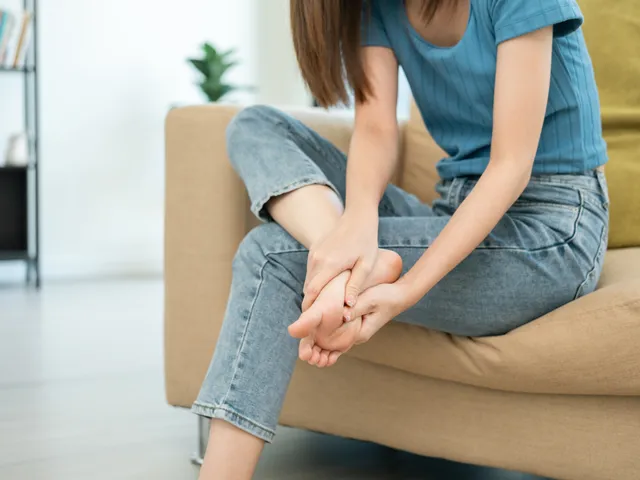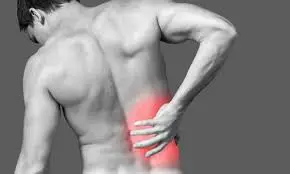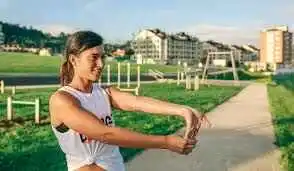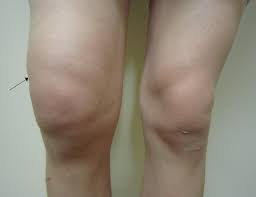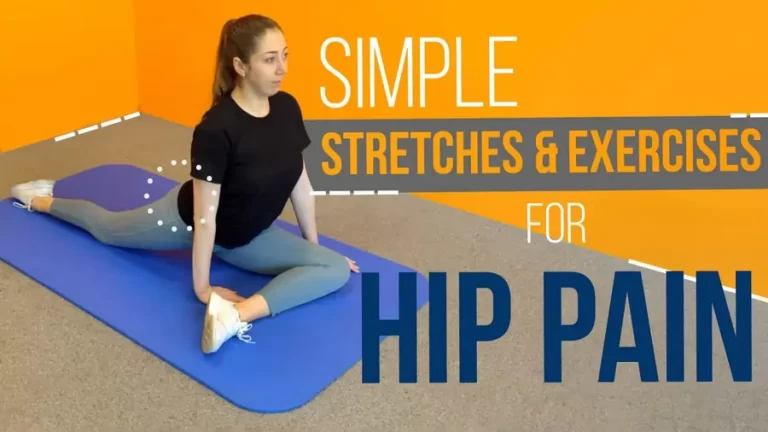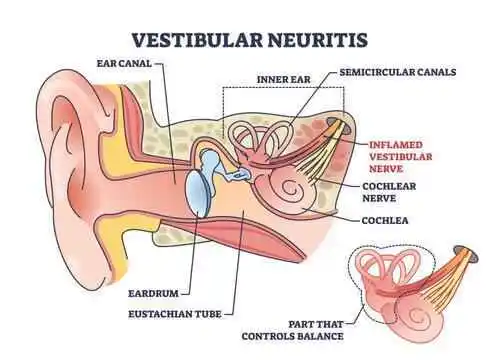Can Knee Pain Cause Foot Pain?
Introduction
Yes, Foot pain can result from knee pain. This is because the lower limb’s knee, foot, and ankle are all interrelated, and issues in one might have an impact on the others. Due to changes in gait and pressure on the feet as a result of compensating for knee pain, foot pain can also be a secondary problem associated with knee pain.
Foot pain frequently results from knee pain, particularly when the knee problem modifies how the body grows to the pain or alters how the foot and leg work. To avoid bearing weight on the irritating knee, a person with osteoarthritis or a knee injury, for example, may change their walk or place more weight on one foot. Foot pain, especially in the ankles, heels, or arches, may result from this changed weight distribution. Injuries to the nerves in the lower legs or dysfunction caused by knee injuries can also produce foot pain.
People with symptomatic and radiographic knee OA frequently experience foot pain, and the presence of bilateral or ipsilateral foot pain reduces objective physical function measures, depressive symptoms, health-related quality of life, and the severity of knee OA pain and symptoms. Particularly, there were no differences between those who had contralateral foot pain and those who did not, indicating that laterality of foot pain is significant in individuals with knee OA.
Common Causes of Knee and Foot Pain
Due to the body’s basic mechanics, knee and foot pain often result from problems in one area that affect the other. Here are some common causes:
Knee Pain Causes:
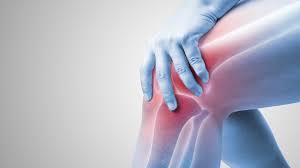
Overuse and Strain
- Running, jumping, and continuous standing are examples of repetitive actions that can cause joint and muscle tension and pain.
Arthritis
- In addition to pain, stiffness, and swelling, osteoarthritis (OA) in the foot or knee can also cause other symptoms, such as decreased range of motion and a grating sensation when moving the joint. The degeneration of cartilage in the affected joints causes inflammation and bone-on-bone friction, which results in these symptoms.
Ligament or Meniscus Injuries
- Foot pain can result from knee diseases such as meniscus damage or ACL rupture. ACL and MCL tears, meniscus tears, sprains, strains, and fractures can all cause knee pain.
Foot Pain Causes:
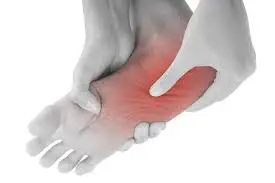
Plantar Fasciitis
- Knee straining may originate from heel pain caused by inflammation of the tissue on the bottom of the foot.
Flat Feet or High Arches
- Problems with foot alignment can affect your gait and increase knee strain. Your walking pattern may change, and your knees may become overworked as a result of your feet’s misalignment, which can also affect how your legs and ankles move.
Gait Imbalances
- You may have pain in one place if you alter your gait because of pain or injury in another.
Symptoms
Knee Pain Symptoms:
- Pain: This can be achy, dull, or sharp, and it can get worse when you move or bear weight, or do certain things.
- Redness and warmth may accompany swelling that develops around the knee joint.
- Stiffness: The knee’s inability to bend or straighten completely.
- Instability: The feeling that the knee might buckle or give way.
- Locking: The sensation that the knee is trapped in an extended or bent position.
- A sound or sensation produced during knee movement is called popping or clicking.
- Challenge Bearing Weight: Your weight may be too much for the knee to bear.
- Gripping or grinding: When you move, you may feel as though your knee is grating or grinding.
Foot Pain Symptoms:
- Heel Pain: Plantar fasciitis may be the cause of heel pain, particularly after rising for the first time after resting.
- Arch Pain: Several diseases, such as flat feet or other structural problems, can result in pain in the arch of the foot.
- Ball of Foot Pain: Damage to the nerves or joints may be the cause of pain in the ball of the foot, which is situated behind the toes.
- Stiffness and edema: Foot pain can cause stiffness, edema, and redness, just like knee pain.
- Foot Shape Changes: Sometimes, foot pain is accompanied by changes in the foot’s shape.
How The Pain Treatment Clinic may assist
At The Pain Relief Clinic, we provide thorough therapy for foot and knee pain by combining non-invasive therapies with exact diagnosis:
- Advanced Imaging: To determine the source of your pain, we can set up MRI scans or other imaging tests in as little as one working day.
- Non-Invasive Solutions: Our therapies reduce inflammation, strengthen joints, and encourage recovery.
- Medisave Support: For help with problems with money, use Medisave to pay for scans and treatments.
When to Call a Doctor
When to See a Doctor About Pain in the Knees:
- Severe Pain: When your knee hurts so much that it makes it difficult to move or support your weight.
- Swelling: Severe knee swelling or redness may be a sign of an injury or illness.
- Deformity: An obvious alteration to the knee’s alignment or shape.
- Unable to Move or Extend: If your knee can’t bend or straighten out all the way.
- Popping Sound: A “popping” sound made during an injury may be a sign of a major injury, such as a torn ligament.
- If the pain doesn’t go away after a few weeks of rest, ice, and over-the-counter painkillers, it’s considered persistent pain.
- Fever or Infection Symptoms: Tenderness, redness, heat, or fever around the knee may indicate an infection.
- Numbness or Tingling: Nerve injury may be the cause of numbness or tingling in your lower leg or foot.
- Interference with Daily Activities: If the pain keeps you from sleeping, working, or engaging in your regular activities, this is an interference.
When to Consult a Physician About Foot Pain:
- Intense pain that makes it difficult to stand or walk is referred to as severe pain.
- Swelling or Redness: Profound swelling or redness surrounding the area that is affected may be a sign of inflammation or infection.
- The inability to use weight to support your foot is known as the incapacity to bear weight.
- Deformity: An obvious alteration in the form of your toes or foot.
- Numbness or tingling: Your foot or toes may experience numbness or tingling due to nerve damage.
- If, after a few weeks of rest, ice, and over-the-counter painkillers, the pain doesn’t go away, it’s considered persistent pain.
- Fever or Infection Signs: An infection may manifest as fever, redness, heat, or pain around the foot.
- Diabetes: Diabetic neuropathy can lead to major consequences; therefore, it’s crucial to consult a doctor if you experience any foot pain or changes.
- Unknown Cause or Pain in Both Feet: See a healthcare provider if you are unsure of the cause of your foot pain or if it affects both of your feet.
Tips for Managing Knee and Foot Pain
- Strengthen Supporting Muscles: Pay particular attention to exercises that target your hamstrings, calf muscles, and quads.
- Put on the Right Shoes: Cushioned, supportive shoes help ease the strain on your feet and knees.
- Stretch Frequently: To increase flexibility and lessen tension, stretch the muscles in your feet and legs.
Red Flags for Knee Pain:
- Weightlessness: If you are unable to support any weight on your knee, it may be a sign of a major injury.
- Visible deformity: A knee that is malformed or deformed could indicate a fracture or dislocation.
- Severe pain and swelling: An illness or major damage may be the cause of sudden, intense pain and swelling.
- In the calf below the knee, numbness, tingling, or bluish discoloration could be signs of a blood clot or nerve injury.
- Warmth, redness, or fever: These signs may indicate an infection, particularly when accompanied by swelling and pain.
- Clicking, locking, or buckling of the knee: These sounds may be signs of a knee joint issue.
- Unable to fully flex or extend the knee: A restricted range of motion may indicate a disease or injury.
- Pain that doesn’t go away after three days of at-home therapy: A visit to the doctor is necessary if pain persists after conservative therapy.
Red Flags for Foot Pain:
- Severe pain, particularly if it strikes unexpectedly: A sprain, fracture, or other injury may be indicated by sudden, severe pain.
- Swelling, particularly if fever or redness are present: Warmth and swelling could indicate an infection, particularly when accompanied by fever.
- It is important to look into numbness or tingling in the foot since it may be a sign of nerve injury.
- If the injured foot is unable to support any weight, it may be a symptom of a severe injury.
- An apparent deformity in the foot could indicate a fracture or dislocation.
- Pain that doesn’t go away with home remedies: It’s crucial to see a doctor if rest, ice, and over-the-counter painkillers don’t help with persistent foot pain.
- Skin changes on the foot or leg: Watch for cuts, redness, or swelling, and have calluses or corns removed by a podiatrist rather than trying to do it yourself.
Treatment
RICE (Rest, Ice, Compression, Elevation), over-the-counter painkillers, physical therapy, and occasionally medication or surgery are some of the methods used to manage knee and foot pain. Self-care techniques like RICE and over-the-counter painkillers can be useful for mild to severe pain. It’s critical to see a doctor for diagnosis and treatment if the pain is severe or doesn’t go away with self-care.
- RICE stands for rest, ice, compression, and elevation. To lessen swelling, elevate the leg, wrap it in compression bandages, and use ice packs for 15 to 20 minutes at a time.
- A mix of activities can be useful for managing foot and knee pain. Stretches like side leg lifts, quad stretches, and the knee stretch, which involves drawing your foot toward your body while seated, are good for knee pain.
- Acetaminophen and NSAIDs (ibuprofen, naproxen) are examples of over-the-counter pain medications that can help lower inflammation and pain.
- Heat therapy: Using heat can help with stiffness by promoting blood flow and relaxing muscles.
- RICE stands for rest, ice, compression, and elevation. To lessen swelling, elevate the leg, wrap it in compression bandages, and use ice packs for 15 to 20 minutes at a time.
- Acetaminophen and NSAIDs (ibuprofen, naproxen) are examples of over-the-counter pain medications that can help lower inflammation and pain.
- Heat therapy: Using heat can help with stiffness by promoting blood flow and relaxing muscles.
Knee Pain Exercises:

- Knee Stretch: Wrap a towel over your ankle, sit on a chair, and slowly draw your foot in closer to your torso. Wait 20 to 30 seconds.
- Stretching your legs involves sitting on the floor, extending one leg, and then moving your foot along the floor while gradually bending the other knee toward yourself.
- Leg raises performed on your side involve raising your upper leg straight up and then lowering it back down.
- With your back against a wall and your feet shoulder-width apart, perform a wall squat by slowly lowering your body as though you were sitting and then raising it back up.
- Squats include lowering yourself as though you were sitting, maintaining a straight back and knees behind your toes, while standing with your feet shoulder-width apart and pointing slightly outward.
- Calf raises include raising your heels while standing on a stair’s edge and lowering them gradually.
Foot Pain Exercises:

- Toe curls, often called pick-ups, are the practice of using your toes to pick up small things.
- Ankle Pumps: Raise and lower your foot slowly.
- Rolling your foot over a golf ball or another item is known as a foot roll.
- Calf Raises: Raise your heels while standing on a stair’s edge, then gradually lower them.
- Wall stretches: Put one leg in front of the other and bend the front knee slightly in the direction of the wall.
- Toe Spreads: As widely apart as you can, spread your toes.
- Foot Doming: Make your foot arch hollow.
- Writing the letters in the air: Write the letters with your big toe.
Prevention
To avoid knee and foot pain, focus on keeping a healthy weight, doing regular low-impact exercise, and using proper body mechanics. Exercises that strengthen the quadriceps and hamstrings, as well as calf raises and squats, should be included. Additionally, pay attention to your flexibility and balance, and think about wearing orthotics and supportive footwear.
Knee Pain Prevention:
- Keep your weight within a reasonable range because carrying too much weight strains your knees, causing pain and more cartilage deterioration.
- Take part in low-impact activities: Pick exercises that won’t put too much strain on your joints, such as swimming, cycling, walking, or water aerobics.
- Build up your supporting muscles: To support your knee joints and lessen pain, strengthen your hamstrings and quadriceps.
- Maintain proper posture: To reduce knee strain, be mindful of your posture both when standing and when sitting.
- Avoid knee-stressing activities: Restrict or stay away from kneeling, deep knee bends, and running downhill.
Foot Pain Prevention:
- Select supportive footwear: Put on shoes that fit properly and provide enough arch support.
- Practice good foot hygiene: To avoid infections and other issues, keep your feet dry and clean.
- Stretch your feet frequently to increase flexibility and avoid foot pain.
- Take care of any underlying issues: Get the right care or modifications if you have bunions, flat feet, or other foot issues.
- Stay hydrated: Dehydration can cause foot pain and other muscular issues.
- Think about orthotics: Custom foot orthotics can help relieve lower limb and foot pain and improve foot alignment.
Conclusion
Laterality is important in foot pain. Health and functional status can be greatly impacted by both bilateral (pain on both sides) and ipsilateral (pain on the same side as a knee problem) foot pain, especially in those with osteoarthritis (OA) of the knee.
People with knee OA frequently experience foot pain. To evaluate the therapy of foot pain in this population and to determine the mechanism and interplay of pathology at various sites, further study is required.
FAQs
Can knee pain be caused by weak feet?
Stability caused by a weakening of the intrinsic muscles of the foot might impact how the knees move and support weight. For example, as we have already discussed, flat arches can lead to the feet collapsing inward, which alters the knee joint’s position and strains the ligaments and tendons.
How might flat feet prevent knee pain?
In addition to treating a variety of other linked issues in the foot, back, or hip, foot orthotics frequently offer nearly instant relief from knee pain caused by flat feet. You may need to switch up your shoes if you are experiencing foot issues. There may be a shoe model designed just for your foot type.
What is the quickest treatment for knee pain?
The RICE method is a home remedy for knee pain: Rest: To keep the injury from getting worse, stop the physical activity that was causing the pain. Ice: For 15 to 20 minutes each hour for the first day following your injury, apply an ice pack or cold compress. Ice should be applied every three to four hours after a day.
What’s causing my foot pain?
Injuries, excessive use, poorly fitting footwear, and underlying medical disorders are some of the reasons for foot pain. Plantar fasciitis, tendonitis, bunions, and nerve disorders such as Morton’s neuroma are common causes. Pain can also be exacerbated by activities that strain the feet or by wearing shoes that don’t adequately support the feet.
Do foot and knee pain have a connection?
Since abnormal foot posture and function have been shown to alter knee biomechanics and joint load, there is a proposed mechanism via which foot and knee pain may be related in those with symptomatic knee OA.
Why are my feet and legs injured?
Injuries or illnesses affecting the joints, bones, muscles, ligaments, tendons, nerves, or other soft tissues may also be the cause. Issues with your lower spine may be the cause of certain types of leg pain. Varicose veins, blood clots, or inadequate blood flow can also result in leg pain.
Reference
- Paterson, K. L., Hinman, R. S., Hunter, D. J., Wrigley, T. V., & Bennell, K. L. (2015). Impact of Concurrent Foot Pain on Health and Functional Status in People with Knee Osteoarthritis: Data From the Osteoarthritis Initiative. Arthritis Care & Research, 67(7), 989–995. https://doi.org/10.1002/acr.22537
- Knee and foot pain: Understanding the causes and finding effective relief. (2025, January 26). Singapore Pain Clinic Doctor. https://painrelief.com.sg/knee-foot-pain-understanding-causes-finding-effective-relief/

